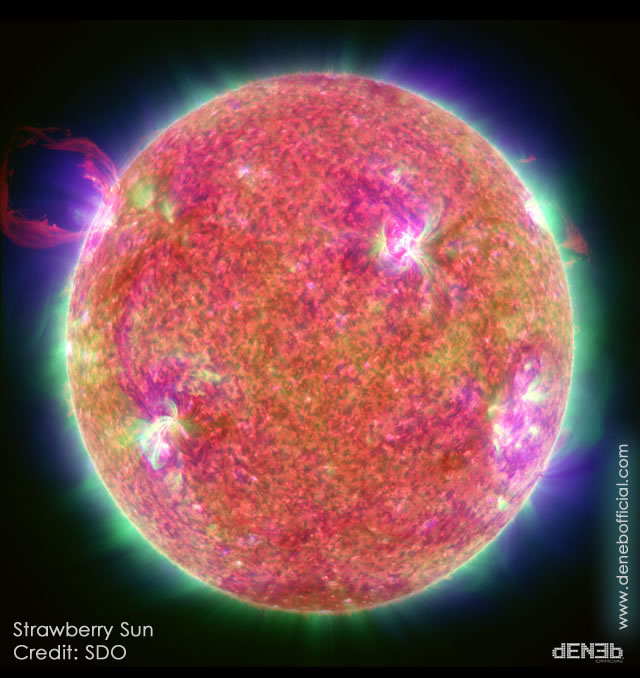
Il Sole “Fragola” – Strawberry Sun – Credit: SDO
Macchie, brillamenti, emissioni di massa coronali. I fenomeni più eclatanti e violenti che produce il Sole sono tutti legati da un unico, potente motore che li alimenta. È il campo magnetico solare che con la sua dinamica regola praticamente tutte quelle che sono le manifestazioni dell’attività della nostra stella.
Una dinamica che è profondamente legata a quello che avviene nella zona convettiva del Sole, ovvero nel guscio che va da una profondità di circa 200.000 chilometri fin quasi alla sua superficie. In questa regione, l’energia prodotta dalla fucina nucleare al centro della stella viene trasportata verso l’esterno attraverso lo spostamento del plasma, che risalendo si raffredda per poi ridiscendere. Un po’ come accade in una pila di acqua bollente. In questi moti turbolenti il plasma attraversa il campo magnetico interno del Sole producendo, come una gigantesca dinamo, intense correnti elettriche in grado di rafforzare il campo magnetico. Campo magnetico che in parte viene trasportato in superficie dal plasma stesso, andando a modellare l’atmosfera solare e trasferire in essa energia. Dietro a questa visione che oggi abbiamo del fenomeno della dinamo solare, seppur piuttosto completa e dettagliata, si celano notevoli complicazioni quando gli scienziati tentano di ricostruirla tramite simulazioni al computer. I problemi sono sostanzialmente di due tipi: il primo riguarda i modelli stessi che descrivono il comportamento di un ambiente così complesso come l’interno di una stella e le interazioni del plasma in movimento con i campi magnetici. Le equazioni in gioco devono tenere conto di fenomeni di tipo turbolento, assai difficilmente riproducibili se non tramite complessi insiemi di equazioni. Il secondo è la sua naturale conseguenza. Per ricostruire il comportamento del nostro Sole dal punto di vista globale è infatti necessaria una potenza di calcolo grandissima. Questa richiesta di computer super potenti cresce esponenzialmente se si cercano simulazioni sempre più accurate. Nuovi e incoraggianti sviluppi in questo settore vengono riportati in un articolo apparso online sulla rivista Science e scritto da Paul Charbonneau, dell’Università di Montreal e Piotr Smolarkiewickz dell’European Centre for Medium Range Weather Forecasts di Reading, nel Regno Unito. I due ricercatori, specialisti di modellistica solare, sottolineano come grazie a recenti simulazioni, sia stato riprodotto in modo piuttosto regolare e continuativo il fenomeno dell’inversione della polarità del campo magnetico della nostra stella. L’inversione risulta verificarsi ogni 40 anni circa, un intervallo di tempo che è ancora quasi quattro volte maggiore di quello che avviene in realtà nel Sole, ma comunque un significativo passo avanti rispetto alle altre simulazioni ‘concorrenti’ finora proposte che, in taluni casi, hanno fornito risultati contraddittori o addirittura del tutto opposti a quello che è il comportamento della nostra stella.
Fonte/Leggi tutto → Media.INAF.it
A research team made up of Paul Charbonneau, a physicist with the University of Montreal and Piotr Smolarkiewicz, a weather scientist with the European Centre for Medium-Range Weather Forecasts in the U.K., has created a new kind of computer simulation of the sun’s energy flow.
In their Perspective article published in the journal Science, the two describe the solar engine deep within the sun as its “heartbeat” and suggest that it underlies virtually all solar activity. To gain a better understanding of how the sun works, the two researchers created a simulation that models the sun’s entire magnetic field activity—no small feat. They ran their simulation on University of Montreal supercomputers which are connected to a larger network across the city. In so doing, they observed that though the sun as a whole experiences an 11 year cycle of solar polar reversals (as noted here on Earth by the periodic nature of observable sun spot activity), zonal magnetic field bands undergo a polarity reversal on average every 40 years. Scientists have for years been trying to model the sun, but thus far attempts to do so have been lacking. The problem is that there is so much going on and the sun is so huge—to simulate it all requires more computing power than is available. At the root of all the simulations is turbulence, which is where a gas or fluid flows in a chaotic fashion. The new model shows that turbulence in the sun comes from within and flows outwardly, dissipating into ever smaller vortices, but it, like other simulations can only model this dissipation to a certain degree. At some point, the vortices are as small as just meters across and thus are too small to include in a model because there are just too many of them. The simulation built and run by Charbonneau and Smolarkiewicz goes as far as modern computers are able and shows the suns’ action as a dynamo—where the amplification of a magnetic field is self-sustained due to fluid motion action.
Studying the sun and how it works is not purely academic, of course, learning how to accurately predict solar flares—when they might occur and how large they might be, would be very useful as the world becomes more and more dependent on sensitive electronic instruments that can be adversely impacted by events on the sun.
Source/Continue reading → Phys.org





















